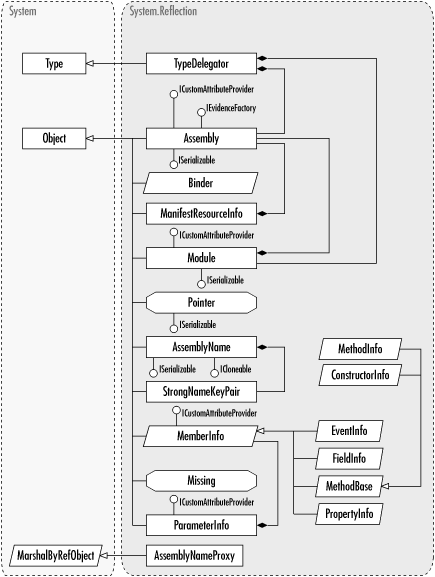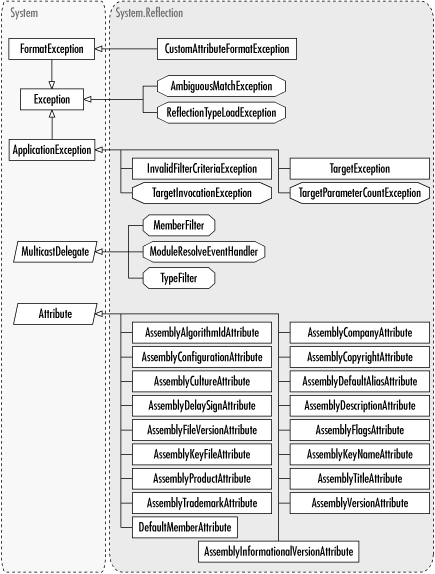| [ Team LiB ] |
|
Chapter 35. System.ReflectionSystem.Reflection is the API that exposes the full-fidelity metadata of the .NET environment to the .NET programmer. In short, it permits complete access to compile-time data at runtime. Everything is available, including fields, methods, constructors, properties, delegate types, and events. The reflection API (as exposed by the System.Reflection namespace) offers some truly unique capabilities unavailable in other compile-time bound languages such as C++. The closest the average COM programmer has come to using reflection is the IDispatch interface and/or type libraries. Reflection, fortunately, is at once both easier to use and far more powerful. Reflection offers up a number of possible approaches to use. Introspection is the act of using the reflection APIs to discover information about a component assembly (and its constituent types) at runtime without any prior (compile-time) knowledge of it. This approach was first popularized by tools such as Visual Basic and numerous Java IDEs that offered GUI-based construction of visual interfaces. The third-party component was dropped into some well-known location, and the IDE "discovered" it and offered it on a toolbar the next time the IDE was started. Along similar lines, reflection is often used as part of development tools; for example, the .NET utility xsd.exe uses metadata to generate XML Schema documents that correspond to .NET declared types. A .NET programmer could use reflection to generate SQL (Structured Query Language) statements for storing object instances into a relational database, or even into the SQL DDL (Data Definition Language) itself. Other tools could produce remoting proxies, transparently adding the necessary code to marshal and unmarshal parameters and return values across a network connection, even for types that weren't designed to be remoted in the first place. Lastly, reflection isn't just a read-only view of a type's construction; the reflective APIs in .NET also allow for manipulation of methods and state (although not the rewriting of code—once loaded, a type's methods remain exactly as they were defined). The most prevalent example of this sort of usage of reflection is in the .NET Object Serialization code (in the System.Runtime.Serialization namespace). Serialization takes an existing object instance, uses reflection to suck out the object's state, transforms it into a binary representation, and stores that representation (a stream of bytes) to some source, such as a file on disk, a socket, a binary column in a database, and so on. Later, serialization can also take that same stream of bytes and rehydrate the serialized object back into existence. Careful readers will note that last sentence and wonder, if only for a moment, how it could be possible for code to reach into an object and directly manipulate its state; after all, any object-oriented developer worthy of the name knows to mark all fields as "private," which should make said fields completely inaccessible. The fact is, reflection can violate even these most sacrosanct of boundaries—it can reach in and manipulate any private member it finds—thus it is highly sensitive to any changes in the definition of fields inside of a type. Figure 35-1 shows the inheritance diagram for this namespace. Figure 35-2 shows the exceptions, delegates, and attributes from this namespace. Figure 35-1. The System.Reflection namespace Figure 35-2. Exceptions, delegates, and attributes from System.Reflection |
| [ Team LiB ] |
|